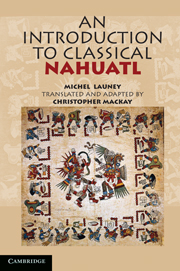Book contents
- Frontmatter
- Contents
- Preface
- How to Use This Book
- PART ONE
- Preliminary Lesson Phonetics and Writing
- Lesson One Intransitive Verbs, Word Order, Absolutive Suffix
- Lesson Two Nouns and Nominal Predicates, the Plural of Nouns, Questions and Negation
- Lesson Three Transitive Verbs
- Lesson Four Emphatic, Interrogative, Demonstrative and Negative Pronouns
- Lesson Five Irregular Verbs, Introduction to Locatives
- Lesson Six Directional and Reflexive Prefixes
- Lesson Seven Quantifiers, Zan, Ye, Oc
- Lesson Eight Preterite Tense
- Lesson Nine Imperative/Optative, Vocative, Future, Imperfect
- Lesson Ten Possessed Forms of the Noun
- Lesson Eleven Inherent Possession, the Suffix -yō, ‘To Have’, Possessive Nouns
- Lesson Twelve Nominal Suffixes, “Adjectives”
- Lesson Thirteen The Principal Locative Suffixes
- Lesson Fourteen Coordination, Phrases of Time and Manner
- Lesson Fifteen Impersonal and Passive Verb Forms
- Review Exercises for Part One
- PART TWO
- Appendix One Traditional Orthography
- Appendix Two The Aztec Calendar
- Appendix Three Inflexional Patterns
- Appendix Four Key to the Exercises
- Nahuatl-to-English Vocabulary
- English-to-Nahuatl Vocabulary
- Index
Lesson Eight - Preterite Tense
Published online by Cambridge University Press: 05 June 2012
- Frontmatter
- Contents
- Preface
- How to Use This Book
- PART ONE
- Preliminary Lesson Phonetics and Writing
- Lesson One Intransitive Verbs, Word Order, Absolutive Suffix
- Lesson Two Nouns and Nominal Predicates, the Plural of Nouns, Questions and Negation
- Lesson Three Transitive Verbs
- Lesson Four Emphatic, Interrogative, Demonstrative and Negative Pronouns
- Lesson Five Irregular Verbs, Introduction to Locatives
- Lesson Six Directional and Reflexive Prefixes
- Lesson Seven Quantifiers, Zan, Ye, Oc
- Lesson Eight Preterite Tense
- Lesson Nine Imperative/Optative, Vocative, Future, Imperfect
- Lesson Ten Possessed Forms of the Noun
- Lesson Eleven Inherent Possession, the Suffix -yō, ‘To Have’, Possessive Nouns
- Lesson Twelve Nominal Suffixes, “Adjectives”
- Lesson Thirteen The Principal Locative Suffixes
- Lesson Fourteen Coordination, Phrases of Time and Manner
- Lesson Fifteen Impersonal and Passive Verb Forms
- Review Exercises for Part One
- PART TWO
- Appendix One Traditional Orthography
- Appendix Two The Aztec Calendar
- Appendix Three Inflexional Patterns
- Appendix Four Key to the Exercises
- Nahuatl-to-English Vocabulary
- English-to-Nahuatl Vocabulary
- Index
Summary
Introduction to the Tenses
In Nahuatl, the principal difference between nouns and verbs is the ability of the latter to express tense and mood and the impossibility of this with the former.
Nahuatl verbs have nine tense and mood forms plus two derived conjugations called directional (22.4, 5). Thanks to its morphological regularity, this system, which we will look at one piece at a time, is actually quite simple.
Each of the nine forms is built upon one of the four verb bases. In this sense, the term “base” signifies a variant of the verb stem.
We have seen (1.1) that all the forms can be derived from the present tense and that the present form is also the dictionary listing. This dictionary form is called base 1 (long base).
We are now going to study the preterite tense. This form pretty much corresponds to the simple past (and occasionally the pluperfect) of English, and is built on base 2.
Principles for Forming the Preterite
The preterite consists of the following elements:
(1) optionally, the augment ō- (8.8)
(2) the regular verb prefixes
(3) base 2 (the short base) of the verb (8.3–7)
(4) the participial suffix (see later discussion)
(5) in the plural, the suffix -ê.
Information
- Type
- Chapter
- Information
- An Introduction to Classical Nahuatl , pp. 69 - 77Publisher: Cambridge University PressPrint publication year: 2011
